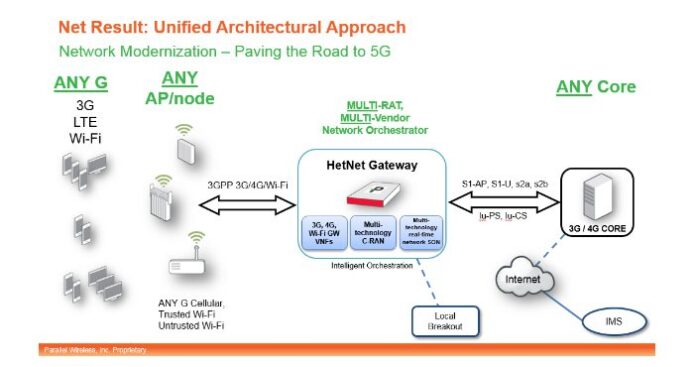The term “HetNets” refers not only to heterogeneity across network technologies, but also to the variety of backhaul technologies and packet cores. As a result of this network variability, there is a need for easy and cost-effective orchestration of all this complexity.
HetNet Gateway (HNG) from Parallel Wireless meets this need. HNG is a 3GPP-compliant, unified solution designed to combine the benefits of gateway VNFs with real-time SON and C-RAN/centralized scheduling to reduce complexity and costs of deploying multi-vendor, multi-technology HetNets.
HNG logically sits between the RAN and core and abstracts RAN on any COTS hardware. HNG virtualizes standard RAN interfaces to manage configurations in real-time while abstracting RAN changes from the packet core network and vice versa.
How is it unique? All virtualized components work as one intelligent solution – HNG supports many ETSI Open VNF-based virtualized gateway network functions that interwork with one another to deliver agility and flexibility across 3G, 4G, Wi-Fi, and multi-vendor networks:
- RAN virtualization for 3G and 4G (vRNC and vHNB gateway for 3G) and vHeNB gateway + veNB for 4G/LTE. HNG presents hundreds of 3G/4G base stations or APs as one “Supercell” to the core, optimizing handover, paging, and signaling. It also virtualizes trusted and untrusted Wi-Fi functionality via ePDG and TWAG VNFs as part of the overall unified virtualized architecture.
- As it is located on HNG that sits between RAN and the core and is not tied in into OSS domain, multi-technology SON has real-time visibility into 3G, 4G, and Wi-Fi traffic to make real-time load balancing and resource optimization decisions across the network. As HNG unifies and abstracts the RAN while orchestrating it in real-time, thus making it self-configuring, self-optimizing, and self-healing, any RAN additions to the network are done quickly, without specialized staff, and without compromising QoE. X2-based Inter-cell Interference Coordination (ICIC) functionality improves the cell-edge experience, as the HNG SON mitigates interference to ensure optimal QoE for each subscriber. HNG acts as a unifier/orchestrator for any-AP/node, anchors the traffic, and handles any mobility handoffs locally. This results in a seamless experience for the wireless users as they switch between different technologies indoors and outdoors.
- Mobile Edge Computing (MEC) that interoperates with industry-standard solutions with SDN + standard X2 for content caching. HNG solution uses standard backhaul and orchestrates a resilient mesh across many backhaul elements to create additional backhaul capacity and enable dynamic content routing.
- By virtualizing both a multi-technology C-RAN and SON on the same platform, HNG creates a coordinated system that provides centralized and elastic scheduling over standard X2. Multi-technology (3G, 4G, Wi-Fi) C-RAN on HNG takes advantage of Moore’s Law for baseband chips and allows operators to keep BBU functionality onsite instead of centrally pooled. This permits operators to take advantage of any type of backhaul without relying on latency-laden and expensive fronthaul.
HetNet Gateway is designed to support any market/vertical that uses radio technology to deliver consistent, reliable coverage at a lower cost for any market: rural, urban, enterprise, or Public Safety.
To learn more, visit www.parallelwireless.com.

